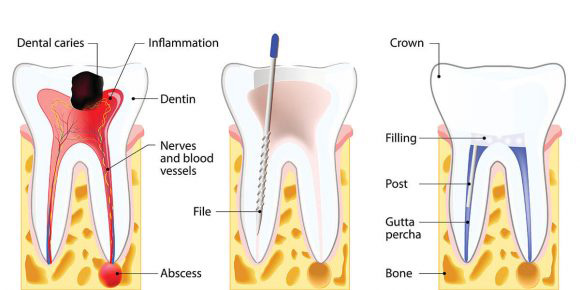
A tooth root canal is not a treatment; it's part of the tooth. It includes the nerve tissue, blood vessels, other cells, and the pulp cavity within a tooth. Teeth are composed of a crown and roots. The head is above the gum, while the seeds are below it. The root connects the tooth to the jawbone. The pulp is located inside the root, referred to as a crown or a canal (also known as a nerve). It moistens the tooth and helps provide dewiness to surrounding tissue, which is why nerves in the pulp detect heat and cold.
Endodontic therapy is the process of treating diseased or damaged teeth inside the mouth. The name "endodontic treatment" is derived from the Greek words for "within" and "tooth," implying that it involves dentistry treatments performed on teeth within the mouth. Even so, clinicians have begun to use the word "root canal" instead of its literal meaning.
If the pulp becomes inflamed or diseased, it cannot heal, and tissues begin to die. Bacteria can reach the pulp of a deep hole, a cracked tooth, or even a loose filling. The bacteria will eventually destroy the pulp. It might be able to start an infection in the bone if germs pass through root openings.
The infection will weaken and break down the bone. We may lose a tooth due to the ligaments around it becoming weak, swollen, and painful to chew. The pulp of the tooth will become sensitive to temperatures. When chewing, there is usually discomfort in the teeth and persistent throbbing pain for some patients. Without treatment, the sickness would spread rapidly. Finally, the tooth would come loose and need to be removed because of bacterial action within the body.

The most common method for removing a tooth is extraction. Individuals are experiencing severe tooth pain or when a tooth cannot be restored, such as extensive, Periodontal disease, gum recession, trauma, or bone loss can all cause tooth loss. And if you remove a tooth this way, neighbouring teeth may begin to shift and become crooked. It can make it challenging to have a good bite if this happens. A root canal treatment is generally successful in saving the tooth and alleviating pain.
If root canal therapy fails to save the tooth, implant treatment is the next best alternative. However, if feasible, preserving a natural tooth is always your top choice because nothing compares to a natural tooth in terms of function.
Following a root canal treatment, you should consider getting a porcelain or zirconia crown placed over the tooth to help prevent tooth fractures. This is particularly useful if extensive restoration was done and only a thin shell of a tooth remained. If passage therapy causes pain, swelling, or other problems, you may require further treatment from our dentist. To see whether additional work is required.
Root canals are painful and unpleasant, but they're something that everyone has to endure. When you need a root canal, you want it done correctly the first time. Marmaris Dental Center provides affordable services, high-quality dental treatments (cosmetic dentistry) as well as an extensive background in performing root canals.
Please send us email to get further information and get pricing.
